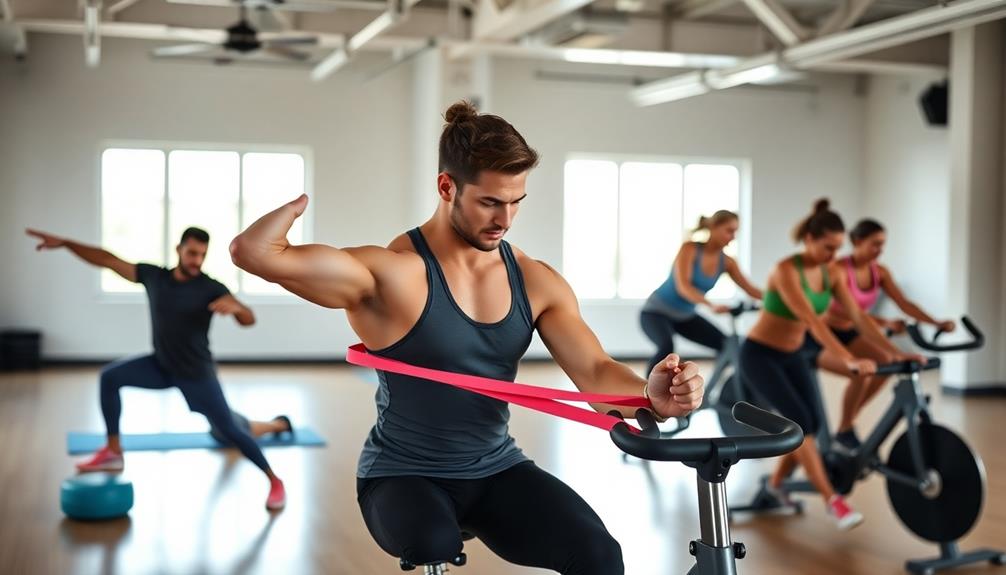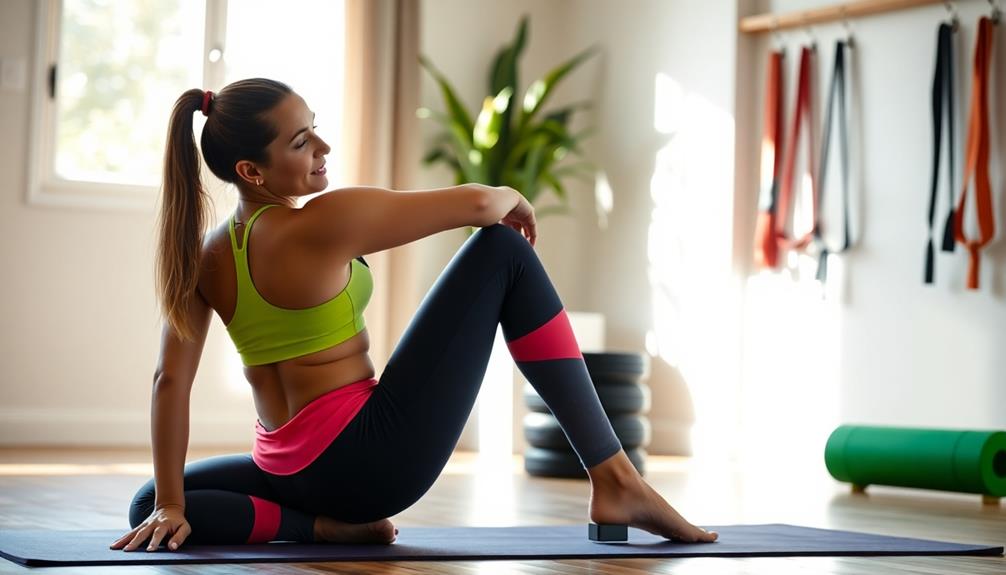To optimize muscle recovery, incorporate these 10 essential routines into your training regimen: active recovery workouts, foam rolling, proper post-workout nutrition, contrast water therapy, sleep optimization, stretching, massage, meditation, cryotherapy, and self-myofascial release. These techniques target various aspects of recovery, from reducing muscle soreness to improving flexibility and promoting relaxation. You'll boost blood flow, reduce inflammation, and enhance overall recovery by combining low-intensity exercises, targeted stretching, and nutrition strategies. Don't forget to listen to your body and gradually introduce new methods. By implementing these routines, you'll be well on your way to faster recovery and improved athletic performance. Explore each technique to discover the best combination for your needs.
Core Insight
- Incorporate active recovery workouts like light jogging or swimming to boost blood flow and enhance muscle recovery.
- Use foam rolling and stretching techniques to target specific muscle groups and improve flexibility.
- Consume a balanced post-workout meal with a 3:1 carb-to-protein ratio within 30 minutes of exercise.
- Utilize contrast water therapy or cryotherapy to reduce inflammation and alleviate muscle soreness.
- Prioritize quality sleep and practice meditation to promote overall recovery and reduce stress on the body.
Active Recovery Workouts

Many athletes forget how important active recovery workouts are for training. Low-intensity exercises can make a big difference in muscle recovery and overall performance. Try adding light jogging, swimming, or cycling to your routine. These exercises boost blood flow to your muscles, which helps remove toxins and deliver nutrients. Compression gear for recovery can also help by improving circulation and reducing muscle soreness.
To get started, do 20-30 minutes of active recovery on rest days. Pick exercises that work different muscles than the ones you just trained hard. For example, after an intense leg day, try some easy upper body exercises or go for a swim. Keep the intensity low – you shouldn't be breathless or straining. Active recovery isn't about pushing yourself; it's about helping your body heal and get ready for your next tough workout.
Foam Rolling Techniques

Foam rolling is a great way to help your muscles recover after a workout. It targets specific areas to break up knots, boost blood flow, and make you more flexible. Focus on rolling your quads, hamstrings, calves, IT bands, and upper back.
To do it right, put the foam roller under the muscle you want to target. Gently press down as you roll back and forth slowly. If you find a tender spot, pause there for 20-30 seconds. Take your time and spend 1-2 minutes on each muscle. As you roll, you'll feel the tension release. Just breathe deeply and let your body relax.
For even better results, you can use cooling towels along with foam rolling to reduce swelling and soothe sore muscles. Make foam rolling part of your routine after workouts or on rest days. The more you do it, the less sore you'll be and the faster your muscles will recover.
Proper Post-Workout Nutrition

Eating right after your workout is key for muscle recovery. Aim to eat both protein and carbs within 30 minutes of finishing. Protein fixes and builds muscle, while carbs refill energy stores. Try to get 15-30g of protein from foods like protein bars. The best amount depends on your weight and how hard you worked out.
For carbs and protein, a 3:1 ratio is ideal. A protein shake with fruit, yogurt and berries, or a turkey sandwich all work well. And don't forget to drink plenty of water. It moves nutrients to your muscles and removes waste.
Contrast Water Therapy

Contrast water therapy helps athletes recover after intense workouts. You alternate between hot and cold water to reduce soreness and feel better. Start in warm water for a few minutes, then switch to cold. Repeat this a few times. It can help:
- Reduce swelling
- Boost blood circulation
- Ease muscle aches
- Move better
- Recover faster
For a quick option, try cold compression wraps. They target specific body parts to treat them.
At home, use two tubs or buckets with warm and cold water. Begin with 3-4 minutes in warm (98-104°F), then 30-60 seconds in cold (50-59°F). Do this 3-4 times, ending with cold. Pay attention to how your body feels and change the time and temp if needed.
Sleep Optimization Strategies

Getting good sleep is crucial for athletes to recover and perform their best. To sleep better, go to bed and wake up at the same time every day. Aim to sleep for 7-9 hours straight through the night. Make your bedroom a great place to sleep by keeping it cool, dark, and quiet. Stop using screens like your phone or TV at least one hour before bedtime because the blue light can mess with your sleep cycle.
Try these other tips to sleep even better:
| Strategy | Benefit |
|---|---|
| Meditation | Helps you relax and worry less |
| White noise | Covers up sounds that might wake you |
| Comfortable bedding | Makes sleeping more cozy |
| Herbal tea | Helps you unwind before bed |
Compression Gear Usage

Compression gear is becoming more and more popular with athletes who want to recover from tough workouts. You can find compression clothing for different parts of your body. Wearing these clothes after intense exercise can help reduce muscle soreness and improve blood flow. While compression gear helps, it's also important to eat well after working out. Good nutrition is key for muscle recovery too.
Here's how compression gear helps you recover:
- Reduces muscle swelling and inflammation
- Improves lymphatic drainage
- Gets more oxygen to your muscles
- Cuts down on muscle vibration during exercise
- Supports your joints and muscles
To benefit the most from compression gear, wear it while you exercise and afterward. It works even better when you also drink plenty of water and stretch. Keep in mind, compression gear isn't a magic fix. But when used right, it can be a helpful tool in your recovery plan.
Stretching and Flexibility Routines

Stretching and flexibility routines are important for athletes to recover well. You should do both static and dynamic stretches. Static stretches are when you hold a position for 15-30 seconds, focusing on specific muscles. Do these after exercise when your muscles are warm. Dynamic stretches involve active movements that are similar to your sport. They're great for warming up before training or competition. To improve flexibility and muscle recovery, try using a foam roller to target specific muscles and release tension in hard-to-reach areas.
Focus on stretching major muscle groups and areas that tend to get tight, like hamstrings, quadriceps, and hip flexors. Don't forget to stretch your upper body too, including shoulders and back. Try to stretch for at least 10-15 minutes every day. You can also try yoga or Pilates to work on flexibility. Remember, consistency is important for improving your flexibility and reducing your risk of injury.
Massage and Self-Myofascial Release

Massage and self-myofascial release are important parts of an athlete's recovery. They reduce muscle tension, improve blood flow, and make you more flexible. You can get professional massages or do it yourself at home. Firm foam rollers are great for deep tissue massage, especially on big muscles. They stay firm and keep their shape over time.
Professional massages target specific areas, while self-myofascial release is good for daily upkeep. Use tools like foam rollers or massage balls. Focus on:
- Big muscle groups
- Trigger points
- Tight areas
- Overused muscles
- Sore or knotted spots
Start gently and press harder as needed. Roll slowly for 30-60 seconds on each spot, spending more time on tight areas. Do this after workouts or on rest days for best results. Stick with it to see the most benefit.
Meditation and Mindfulness Practices

Meditation and mindfulness are great for an athlete's recovery. They help you relax, focus better, and feel less stressed. This is really important for helping your muscles recover.
To add meditation and mindfulness to your routine, try these tips:
- Begin with short 5-10 minute sessions
- Use apps or videos for guided meditation
- Take deep breaths
- Do a body scan
- Stretch while being mindful
Check out this simple guide to get started:
| Technique | Benefits | Duration |
|---|---|---|
| Deep breathing | Less stress | 5 minutes |
| Body scan | More aware of your body | 10 minutes |
| Guided meditation | Better focus | 15 minutes |
| Mindful stretching | More flexible | 10 minutes |
| Visualization | Improved performance | 5 minutes |
Cryotherapy and Ice Baths

Cryotherapy and ice baths are popular ways for athletes to recover after intense workouts. They work by reducing swelling, dulling pain, and narrowing blood vessels. When you finish, blood flows back to your muscles, which may speed up recovery. These cold treatments might also help athletes focus better during training by improving mental sharpness and brain function.
Key points:
- Cryotherapy uses very cold air for 2-3 minutes
- Ice baths involve sitting in 50-59°F water for 10-15 minutes
- Both can lessen muscle soreness and tiredness
- They may help you sleep better and strengthen your immune system
- Always follow safety instructions and talk to an expert
These methods aren't right for everyone. Pay attention to how your body responds and start gradually if you're trying cold therapy for the first time. Don't forget, recovery is just as critical as the training itself.
Frequently Asked Questions
How Long Does It Take for Muscles to Fully Recover After Intense Exercise?
You'll typically need 24-72 hours for full muscle recovery after intense exercise. It depends on your fitness level, workout intensity, and recovery practices. Proper nutrition, sleep, and active recovery can speed up the process.
Can Certain Supplements Enhance Muscle Recovery and Reduce Soreness?
Yes, you can enhance muscle recovery and reduce soreness with certain supplements. Try using protein powders, BCAAs, creatine, and omega-3 fatty acids. They'll support muscle repair, decrease inflammation, and boost your overall recovery process after intense workouts.
Are There Any Specific Recovery Techniques for Older Athletes?
You'll benefit from low-impact activities, like swimming or yoga. Don't skip stretching and incorporate longer warm-ups. Try compression garments, massage therapy, and adequate rest. Proper nutrition and hydration are essential for your recovery as an older athlete.
How Does Dehydration Affect Muscle Recovery and Performance?
Dehydration greatly impairs your muscle recovery and performance. You'll experience reduced blood flow, slower nutrient delivery, and increased muscle fatigue. It also hampers your body's ability to remove waste products, leading to longer recovery times and decreased strength.
What Role Do Genetics Play in an Athlete's Muscle Recovery Speed?
Your genes greatly influence your muscle recovery speed. They affect protein synthesis, inflammation response, and oxidative stress handling. You'll find some athletes naturally recover faster, while others need more time due to their genetic predisposition.

